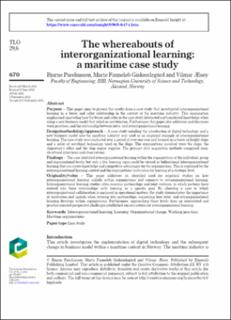| dc.contributor.author | Pareliussen, Bjarne | |
| dc.contributor.author | Giskeødegård, Marte Fanneløb | |
| dc.contributor.author | Æsøy, Vilmar | |
| dc.date.accessioned | 2023-02-20T10:12:18Z | |
| dc.date.available | 2023-02-20T10:12:18Z | |
| dc.date.created | 2022-11-23T13:24:42Z | |
| dc.date.issued | 2022 | |
| dc.identifier.citation | Learning Organization. 2022, . | en_US |
| dc.identifier.issn | 0969-6474 | |
| dc.identifier.uri | https://hdl.handle.net/11250/3052271 | |
| dc.description.abstract | Purpose
This paper aims to present the results from a case study that investigated interorganizational learning in a buyer and seller relationship in the context of the maritime industry. This examination emphasized unraveling how the buyer and seller in the case study interacted and transferred knowledge when using a new business model that relied on servitization. Furthermore, this paper also addresses and discusses work practices, and the relationship between intra- and interorganizational learning.
Design/methodology/approach
A case study entailing the introduction of digital technology and a new business model into the maritime industry was used as an empirical example of interorganizational learning. The case study was conducted over a period of over one year and focused on a buyer of freight ships and a seller of servitized technology used on the ships. The organizations involved were the ships, the shipowner’s office and the ship engine supplier. The primary data acquisition methods comprised semi-structured interviews and observations.
Findings
The case identified interorganizational learning within the organizations at the individual, group and organizational levels, but only a few learning signs could be viewed as bidirectional interorganizational learning that can create knowledge and competitive advantages for the organizations. This is explained by the interorganizational learning context and the organizations’ motivation for learning at a strategic level.
Originality/value
This paper addresses an identified need for empirical studies on how interorganizational learning unfolds within organizations and connects to intraorganizational learning. Interorganizational learning studies often examine partnerships and joint ventures, in which partners have entered into these relationships with learning as a specific goal. By choosing a case in which interorganizational collaboration is anchored in operational matters, the study demonstrates the importance of motivation and agenda when entering into partnerships, concerning how inter- and intraorganizational learning develops within organizations. Furthermore, approaching these levels from an interrelated and practice-oriented perspective challenges established success criteria for interorganizational learning. | en_US |
| dc.language.iso | eng | en_US |
| dc.publisher | Emerald Publishing Ltd. | en_US |
| dc.rights | Navngivelse 4.0 Internasjonal | * |
| dc.rights.uri | http://creativecommons.org/licenses/by/4.0/deed.no | * |
| dc.title | The whereabouts of interorganizational learning: a maritime case study | en_US |
| dc.title.alternative | The whereabouts of interorganizational learning: a maritime case study | en_US |
| dc.type | Peer reviewed | en_US |
| dc.type | Journal article | en_US |
| dc.description.version | publishedVersion | en_US |
| dc.source.volume | 29 | en_US |
| dc.source.journal | Learning Organization | en_US |
| dc.source.issue | 6 | en_US |
| dc.identifier.doi | 10.1108/TLO-11-2021-0129 | |
| dc.identifier.cristin | 2079245 | |
| cristin.ispublished | true | |
| cristin.fulltext | original | |
| cristin.qualitycode | 1 | |

